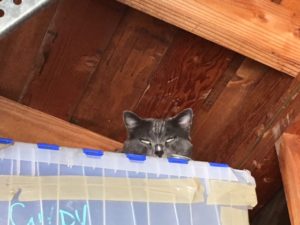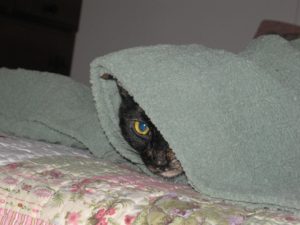 Do you ever go looking for your cat and discover, after several minutes or more, that she’s hiding right under your nose? Before leaving your house do you check to see where your cats are? We’ve been known to close a cat in a closet—I mean, who hasn’t done that? And do you profusely apologize when you finally locate your cat in a closet, cupboard, high up on a shelf, or, heaven forbid, the refrigerator? Does it do any
Do you ever go looking for your cat and discover, after several minutes or more, that she’s hiding right under your nose? Before leaving your house do you check to see where your cats are? We’ve been known to close a cat in a closet—I mean, who hasn’t done that? And do you profusely apologize when you finally locate your cat in a closet, cupboard, high up on a shelf, or, heaven forbid, the refrigerator? Does it do any  good? I mean, how can you explain to a cat, who has been deprived of his freedom for a couple of hours, that you didn’t mean to do it.
good? I mean, how can you explain to a cat, who has been deprived of his freedom for a couple of hours, that you didn’t mean to do it.
Why do cats like to hide? I guess it goes back to their roots. In the wilds, it’s either stay hidden or be eaten. Cats also need a good  cover when they’re hunting for their dinner so they can get the drop on the varmint. Just watch your cat’s movements and activities throughout the day. While his antics may seem like play and he looks really cute peering out from under the sofa, in reality he’s probably acting on instincts carried over from his wild ancestors. When he leaps out at you when you walk into a room, he’s emulating a wild cat attacking his prey.
cover when they’re hunting for their dinner so they can get the drop on the varmint. Just watch your cat’s movements and activities throughout the day. While his antics may seem like play and he looks really cute peering out from under the sofa, in reality he’s probably acting on instincts carried over from his wild ancestors. When he leaps out at you when you walk into a room, he’s emulating a wild cat attacking his prey.
I can’t help but smile when I see Lily or Sophie staring out from their tunnel or from  under the bed spread. But I have to wonder what’s really going through their mind? Are they imagining being on a hunt in the jungle or plains or are they oblivious to why they’re hiding? Is the instinct connected to a long-held memory or is it simply DNA guiding them blindly in these activities?
under the bed spread. But I have to wonder what’s really going through their mind? Are they imagining being on a hunt in the jungle or plains or are they oblivious to why they’re hiding? Is the instinct connected to a long-held memory or is it simply DNA guiding them blindly in these activities?
Here are some hiding cats—Pearl follows this blog. This is her Little Kitty looking down from a high place with a couple of teddys. Smokey likes to hide up high in the garage too. Here’s Lily trying to camouflage herself in a newspaper and Sophie under a blanket.





